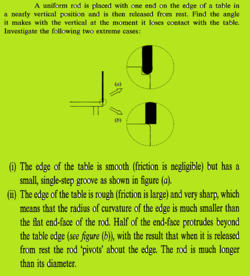This section requires Javascript.
You are seeing this because something didn't load right. We suggest you, (a) try
refreshing the page, (b) enabling javascript if it is disabled on your browser and,
finally, (c)
loading the
non-javascript version of this page
. We're sorry about the hassle.

Here ya go, Anish or Mr Puthuraya whichever you'd prefer. I tried to make it concise... So, I might have skipped some steps.
So things like, conservation of energy is really useful when it comes to determining things like the rod's angular velocity which I denote as ω when the inclination is some angle θ .
And also the components of the reaction between the table and the rod to the accelerations they produce.
In the first case, the smooth horizontal and vertical walls of the groove can exert only vertical and horizontal forces on the end of the rod, respectively.
In the second case, the edge of the table is a very small quarter-circle, so the normal force is always directed along the rod's axis.
First of all, let's look at the gravitational potential energy that is lost as the rod falls through at an angle θ ⇒ M g 2 h ( 1 − c o s θ ) . Conservation of energy ⇒ is turned into rotational kinetic at around the edge of the surface table looking thingy.
Now using Huygens-Steiner theorem, we can find the relevant moment of inertia of the rod.
⇒ 3 1 M h 2 .
Hence, we get ω 2 = l 3 g ( 1 − c o s θ ) .
Centripetal acceleration = 2 h ω 2 = 2 3 g ( 1 − c o s θ )
With same moment of inertia and instantaneous torque = M g 2 h s i n θ , hence we can get the tangential acceleration (of the rod) = 4 3 g s i n θ
Now, let's look at the case #1. The surface be frictionless, so the horizontal and vertical walls can exert positive vertical and horizontal forces. Call the V and H (for horizontal and vertical) on the end of the rod.
The rod will lose contact with the table when one of them = 0.
Looking at forces horizontally and vertically gives us the following equations:
I'm not very good at using LaTeX... so I did that on paint. Figure
Figure
And then solving for those equations, we get:
H = 4 3 M g s i n θ ( 3 c o s θ − 2 ) a n d V = 4 1 M g ( 3 c o s θ − 1 ) 2
The first reaction component will H and this happens ⟺ a r c c o s 3 2 . Cause, if the angle is larger, H will be negative ⇒ rod loses contact with table.
arccos 3 2 = 4 8 . 1 8 9 blah blah blah. Now that's the angle for case 1.
Now for case 2. A very small quarter circle... Now, the normal force, call it n is always directed along the rod's axis.
The static friction force is tangential to the quarter-circle, aye? The magnitude can be anything, depending on the rough edge.
We can find the centripetal force by adding the component of the rod's weight along the rod and the normal force.
Hence, the normal force n = 2 M g ( 5 c o s θ − 3 ) .
The reaction of the table on the rod = 0 when n = 0 .
In other words, arccos 5 3 = θ , larger angles results in a negative normal force so it would not be possible. The rough surface, ie the static friction force is large enough to prevent actual slipping unless when the normal force = 0.
That's case 2.
So we got the angles as being a r c c o s 3 2 and a r c c o s 5 3
If you subtract them... it is about -4.9.
First ever solution to a nice problem. :-0 So, I'd be happy to see some improvements. I'd probably have made some errors. Took so long as well. Wew... Hope I didn't mess up.